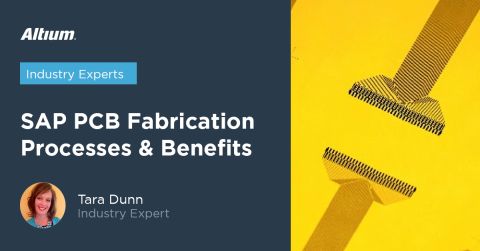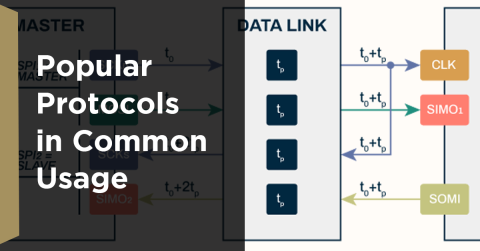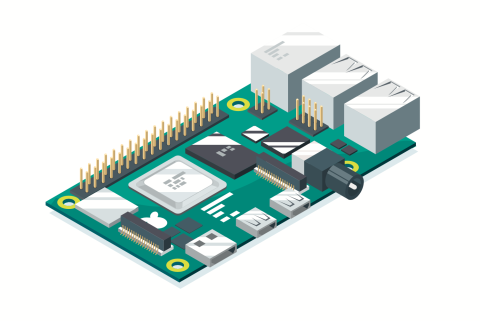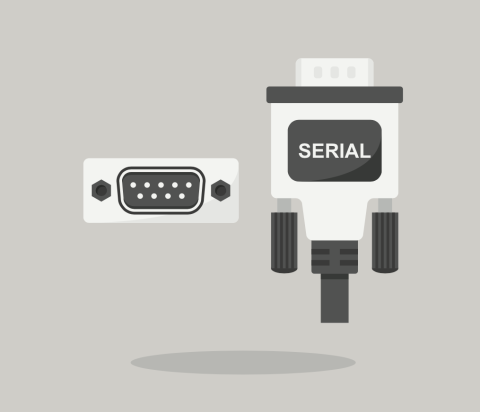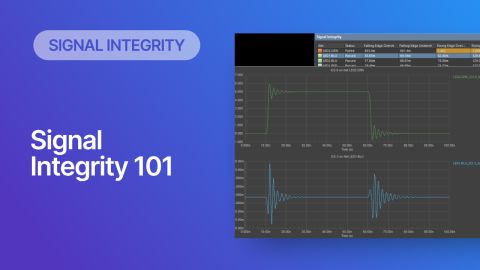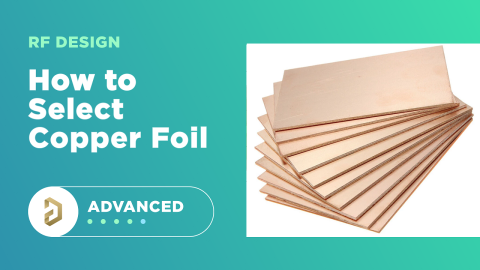Altium Live Question: Digital Signals in a Grounded Coplanar Waveguide?

During my recent talk at AltiumLive 2022 CONNECT, there was a very interesting question from the audience. Someone asked whether it’s possible to put a digital signal through a grounded coplanar waveguide. This is an interesting question that requires looking at the S-parameters of the waveguide, and that is what we’ll look at in this post.
During the Q&A session, I referenced a paper in the literature that contains a set of simulated and measured S-parameter data for grounded coplanar waveguides, and I mentioned these results could be used to determine the limitation of digital signal propagation in a coplanar transmission line. For those interested, a PDF of this paper can be found here:
I have to admit, I’ve never been so succinctly asked whether a grounded coplanar waveguide can support a digital signal. Technically, any interconnect design can support any digital signal as long as it is designed properly. The notion of “designed properly” varies by transmission line type, and it depends on the geometric parameters and substrate material parameters. With that in mind, let’s look at some results for a typical grounded coplanar waveguide from the above paper and see how these predict signal propagation challenges in a grounded coplanar waveguide.
GCPW S-Parameters and Digital Signals
The key to answering this question requires looking at the S-parameters for a grounded coplanar waveguide (GCPW). The S-parameters are influenced by several factors, namely the via placement, spacing to planes and copper pour, and the via density. If you can simulate or calculate the S-parameters for your GCPW, then you can immediately determine the digital signal bandwidth your GCPW can accommodate as it transfers power to a receiver. The same idea applies to any other interconnect, including other coplanar arrangements.
The paper I cite above actually looks at three different coplanar arrangements, which are shown below. Here we have the three standard coplanar arrangements: (a) coplanar with no ground plane, (b) coplanar with ground plane, and (c) the standard GCPW with the via fence lining the trace.

The relevant structure to analyze here is the GCPW in (c). The primary mechanism used to control the S-parameters in the GCPW are:
- Via-to-trace distance (VL): This sets the resonant frequencies corresponding to wave propagation across the trace cross section. Larger spacing moves resonances to lower frequencies.
- Via pitch (VP): This sets the resonant frequencies corresponding to scattering from the via walls; when these cylindrical resonances are excited, there will be strong coupling into the nearby ground and possibly destructive interference along the trace, leading to power loss.
- Copper pour span (SGW): This defines how far around the trace the copper pour spans beyond the edge of the trace. In many practical situations, this can be taken as infinity.
You probably noticed that the dielectric thickness (H) is not in this list; we use this to set the impedance to a specific value. It does affect the amount of loss, as I described in another article on ground clearance. The value of H does create resonances, and I’ll explain why that’s important below. The three parameters listed above are much more important for practical purposes.

The main structure we would be interested in analyzing is the GCPW in (c) as this structure can be reduced to the other structures. For example, (c) can be reduced to (b) by setting VL to infinity, and (b) can be further reduced to (a) by taking the substrate thickness to infinity. With this in mind, let’s look at some of the main results from the paper.
Control S-parameters By Adjusting VP and VL
The values of VP and VL will determine when resonances are excited in the above GCPW structure, and it is these resonances that determine whether large dips in the S21 spectrum will occur. While there isn’t enough room in this article to scroll through every single parameter variation in the paper, there are two graphs that beautifully illustrate how VP and VL affect S21 due to the allowed resonances that can be excited in the cross-section.
In the image below, we can see that reducing the values of VL and VP will push the resonances in the structure out to higher frequencies. We can explain these results in terms of the resonances in the cross-sectional structure shown above. The behavior shown in the graph is exactly what we would expect; increasing the lateral dimensions of the cavity would decrease the resonant frequencies of the cavity, thus we would expect to see peaks and valleys in the S11 and S21 data at lower frequencies.

Here’s the important guideline that one finds from the above data:
- If you make the structure smaller, you can increase the lowest order resonances to higher frequencies, and this increases the bandwidth in the structure. This makes it easier for digital signals to propagate in a GCPW.
Remember, digital signal bandwidths theoretically extend to infinity. Therefore, you want to have as much bandwidth in your channel as possible in order to prevent signal distortion. The high-loss valleys in the above graphs mean that any power concentrated in the signal at those frequencies will be lost. If we look at the power spectrum of a high-speed digital signal as an example, it’s clear that faster signals will be more likely to experience band-limiting at progressively higher frequencies in larger channels because the signal’s power spectrum might overlap with the channel’s anti-resonances.

Reduction to a Coplanar Waveguide with No Ground
The other way to ensure digital signal propagation is to remove the vias completely. So it seems we have two extremes: vias very close together and close to the trace, or no vias at all! In the latter case, the distance between the trace and ground will set the TEM cutoff frequency that limits the bandwidth of the transmission line.
At first glance, adjusting the VL and SGW parameters probably seems least intuitive, until you think about how spreading the copper pour via fence out affects the allowed resonances. It should be clear from the S-parameter data that spreading the copper pour out (SGW → infinity) and using no ground vias reduces the line to having basically no resonances until you look in the z-axis wave propagation direction. In that case, the lowest order resonance will have a wavelength of 2H/(√Dk), where H is the dielectric thickness between the trace and the ground plane. For a 10 mil substrate with Dk = 3, that puts the first resonance at 346 GHz!
Note that the line length and SGW will affect resonances as they enclose a resonant cavity around the line, but in practical situations these may be very large and can be ignored. As a first approach to these designs, focus on setting VL and VP to smaller values to ensure the bandwidth is maximized.
How to Get to a Small Structure
In summary, a GCPW can support digital signal propagation as long as the S-parameters do not create excessive signal distortion, losses, or attenuation. As far as design guidelines for GCPW supporting a digital signal, we have to maximize the resonance-free bandwidth with the following guidelines:
- Try to make VP as small as possible. This is difficult as you have to minimize drill bit size (~6 mils), so you may be limited to VP > 10-15 mil center-to-center distance.
- Try to make VL as small as possible. This is also difficult because you need to leave the same annular ring clearances in the copper pour as you would in a regular via, so you may be limited to VL > 10-15 mils.
If (1) and (2) can be performed, you can expect bandwidths reaching dozens of GHz. This is backed up by the results in the above paper. However, you should still test your own interconnect design.
The other option is to place no vias in the surrounding copper pour and just use structure (a) or (b). If we think about propagation as it is affected by resonances in the surrounding coplanar structure, we see that structure (a) has no resonances until about 1 THz (assuming trace-to-pour spacing = 5 mils), so it has the widest resonance-free bandwidth. However, (a) has the lowest shielding effectiveness. For structure (b), it has no resonances until assuming SGW = infinity, thus it also has bandwidth reaching hundreds of GHz.
|
|
|
|
|
|
|
|
|
|
|
|
When you need to design transmission lines with standard geometries and impedance, you can use the built-in impedance calculator in the Layer Stack Manager in Altium Designer®. All users and their team members can collaborate efficiently on advanced electronics designs through the Altium 365™ platform. Everything you need to design and produce advanced electronics can be found in one software package.
We have only scratched the surface of what is possible to do with Altium Designer on Altium 365. Start your free trial of Altium Designer + Altium 365 today.




